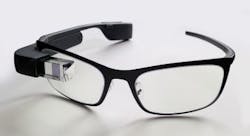Earlier this summer, we reported that The Fraunhofer Institute for Integrated Circuits IIS were adapting its SHORE real-time face detection and analysis software for the Google Glass. The app is used to detect people’s faces and determines their emotions by analyzing facial expressions to the tune of a 91.5% front facial recognition detection rate. Not surprisingly, Fraunhofer researchers aren’t the only ones doing this, as the police force in Dubai has reportedly developed proprietary software for facial recognition purposes.
For those who may be unaware, the Google Glass is a wearable eyeglass device that is equipped with a tiny computer screen mounted in the corner of the eyeglass frame and a 5 MPixel digital camera.Instead of being used to detect people’s emotions and ultimately end up being used for research and medical purposes (Fraunhofer), these glasses will be used in Dubai to “recognize” a suspect based on their face, and alert the officer who is wearing the device.
A spokesman told Reuters that the software was developed specifically for and by the Dubai police, and would be used to enable a connection between the wearer and a database of wanted people. At first, the enhanced Google Glass would be used in a “first phase” to combat traffic violations and track vehicles suspected of involvement in motoring offenses, and the “second phase” would see the device rolled out to detectives.
This isn’t the first news, nor will it be the last, of someone using the Google Glass for purposes other than entertainment (or just looking a bit silly.) There are instances of people using it for documenting surgery, in machine vision, and in the aforementioned Fraunhofer project, which could be used as a communication aid for people with disorders such as autism, many of whom have difficulty interpreting emotions through facial expressions.
Many folks out there who might question the privacy risks of Google Glass, however, will likely note that facial recognition capabilities for the Glass only pushes the envelope further. And once again, it makes me think of that scene in Minority Report, in which Tom Cruise is walking briskly down a hallway and digital billboards are blitzing him with personalized ads as a result of facial recognition technologies. Check it out here, if you haven’t seen the movie.
About the Author

James Carroll
Former VSD Editor James Carroll joined the team 2013. Carroll covered machine vision and imaging from numerous angles, including application stories, industry news, market updates, and new products. In addition to writing and editing articles, Carroll managed the Innovators Awards program and webcasts.
